Kill Screen Magazine's Blog, page 295
February 4, 2015
Höme Improvisåtion: if IKEA made videogames
No no, it's not official, but it does look like a group of game designers may have managed to capture the infernally infuriating experience of putting together IKEA flatpack furniture in virtual reality. Höme Improvisåtion as the game is called (complete with appropriate Scandinavian accents) is apparently one creation to come out of last week's Global Game Jam, a 48-hour event challenging developers to create the best games in a presumably messy weekend of pizza and coding.
Declaring itself "the world's most fun and accurate cooperative furniture assembly experience", the below video gives an amusing introduction to the objective and gameplay. Apparently, the game begins as flatpack furniture box lands at it's own whim in your livingroom (we all know that feeling) leaving you to assemble the pieces before the next items arrive. Oh, it gets worse. The creators have refrained from including assembly instructions in the mix (clearly damaged and vengeful IKEA flatpack veterans/victims) leaving you to assemble the objects in your strange, isometric home on the fly. Don't worry though, these sick sadists offer up some useful troubleshooting advice—"If ever you don't know what to do, just think like a Scandinavian industrial designer."
Apparently, the masterstroke of the game is that a friend can join you to play co-operatively. Much hilarity is sure to ensue as flatpack furniture floods in and crucial pieces from the various items get mixed up in the chaos.
It's time we gave this a go—you can download the game free for PC or Mac here.
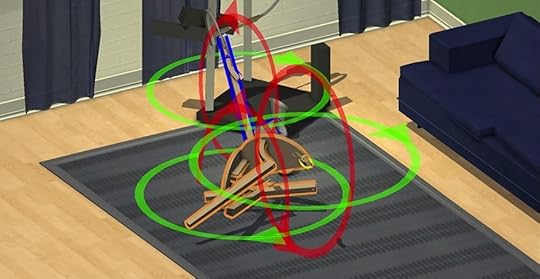
The Legend of Zelda: Majora’s Mask has only grown more important with time
Fifteen years later, the game is almost too real.
Descend into a murderer's tortured conscious in The Guilt and the Shadow
The brain had its own food on which it battened, and the imagination, made grotesque by terror, twisted and distorted as a living thing by pain, danced like some foul puppet on a stand and grinned through moving masks.”
― Oscar Wilde, The Picture of Dorian Gray
Guilt is a complex emotion that reveals much more than just one person's inward state. On a philosophical level, guilt can only exist within a social context: as a response to breaching the moral ground rules that function like a civilization's crowd control. But, on the other hand, guilt lives inside you—manifesting as a lead weight quietly eating away at your innards. Or, at its most extreme, a personal hell invisible to others that you cannot escape.
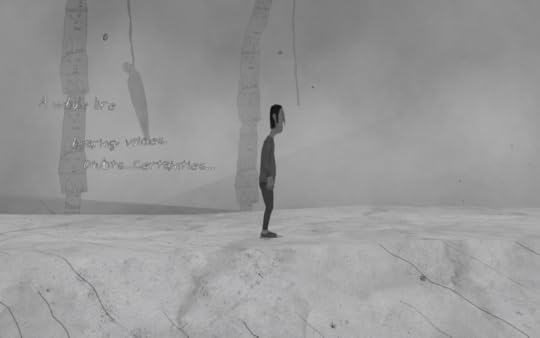
The experience of guilt is both shared yet individual, invisible but also painfully tangible. In The Guilt and the Shadow, a life lived in guilt is represented by a road that you travel down alone, which permeates with the unmistakable sensation of being watched. Fear looms over every corner, yet no actually threat ever really manifests physically.
Originating as a collaboration between Brazilian developer Frederico Machuca and his artist friend Luiz Rodolfo Annes, the first prototype of The Guilt and the Shadow based its narrative off one of Luiz’s short stories. “Personally, I always had an interest in the intense moments of life when people reach their limits,” Frederico says. So they chose the story of a man who, racked with guilt and a need redemption after killing someone, seeks to become a hero.
The tragedy of a mind which can't escape a horror it helped create.
Though the themes of guilt and murder remain in the version of the game released today, the circumstances of the incident shifted dramatically, and with it the context of the protagonist’s guilt. The game reads like an intimate tale about coping with both mental and physical illness: the tragedy of a mind which can't escape a horror it helped create.
Narratively, The Guilt and the Shadow recalls the subtly of Silent Hill 2. As you journey across the environments that embody different facets of the protagonist''s internal torture, you gain a sense of understanding without ever actually receiving any certain answers. By solving symbolic puzzles, you gather only tidbits of the story: of how a loved one's disease lead one man to do things he never thought he was capable of. Like Silent Hill 2, the symbolic nature of the game world delivers more of the story than dialogue or cutscenes. “We wanted to make sure that any new feature, object, or environment we added to the game consistently relayed more of the story,” Frederico says. “Eyes are everywhere, always watching the player, suggesting that maybe the character feels watched in real life too.”
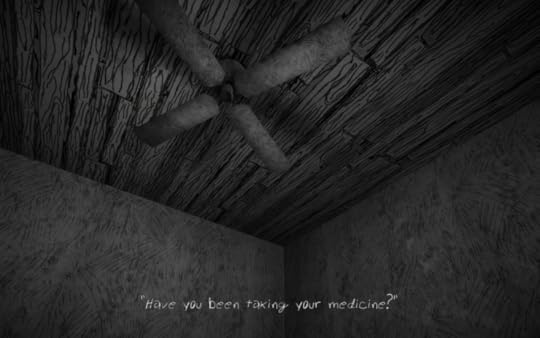
Each time the player collects a pill bottle in the game, a black screen jars them out of the imagined hellscapes of the protagonist’s nightmare, and into a grim, claustrophobic reality. The fixed camera angle focuses on a spinning fan inside a room, as the avatar relays fears, state of mind, hallucinations. Though the game never actually says the words, players come to the realization on their own time: he’s in a psychiatric ward.
Voices follow you throughout the nightmarish hellscapes, manifesting as fragmentary sentences that float rhythmically across the screen. The author of the voice changes, however, alternating between the defensive protagonist and an intimate accuser. The accuser knows him—knows you, and what you did. Your avatars slow steps seem to almost grow heavier, as the voice reminds him of his weaknesses, and the leaded guilt becomes more burdensome with each word.
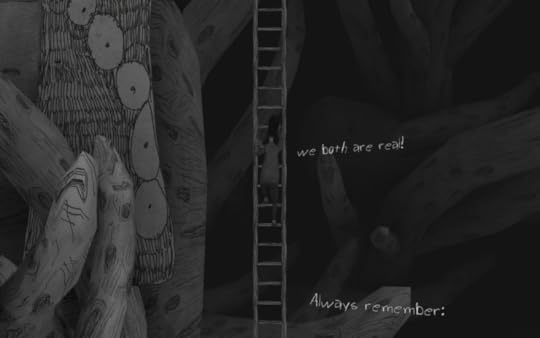
Since 80% of the textures from the game were hand-drawn by Luiz himself, The Guilt and the Shadow establishes a personal atmosphere, providing the perfect setting to explore the grotesque self-induced torture the protagonist must live through. Though solving some of the puzzles can feel unnecessarily laborious, the mechanics for each resonate with the narrative themes. Like the guilt itself, each obstacle is an amorphous shadow: like uncertainty has taken physical form, destroying you from the inside out.
As of today, you can download The Guilt and the Shadow on Steam for free on a Mac and PC. To follow more of the duo’s work, you can follow Frederico on Tumblr and Twitter, as well as Luiz ‘s Tumblr and Twitter.
Shape of the World's creator wants you to get lost in ephemeral beauty
"I find pleasure in getting lost in a place I'm familiar with."
White Night is beautiful, stylish, coming out soon
Part-noir, part-horror, White Night releases March 3rd.
How To Escape
Exploring the potential of the screen, the page and the ceiling.
February 3, 2015
Tokyo 1923 conveys one of Japan's worst natural disasters
In reading Japanese film director Akira Kurosawa's memories of the Great Kantō earthquake of 1923 there appear two images more striking than the rest.
The first one is the bloated corpses that lapped up against the bank of Sumidagawa River: a dirty red assemblage of death that made Kurosawa's knees weak, and that he tried to shutter his eyes to but was forced to stare at by his brother. "I remember thinking that the lake of blood they say exists in Buddhist hell couldn't possibly be as bad as this," Kurosawa wrote.
The other image is much less gruesome but equally as graphic in its depiction of destruction. When the earthquake shook with immediacy in its violence, Kurosawa and a friend clung for dear life to a telephone pole, watching the buildings around them shed their skin. Part of Kurosawa was terrified, but he says one part of his brain was lost in admiration for the way that Japanese houses were built, as the roofs became light and slid tile-by-tile from the wooden frames rather than collapsing in on them.
the abstract layout denotes the chaotic architecture of a city torn apart
It's this second image that the small team behind Tokyo 1923, a small exploratory platformer made for the Global Game Jam, have seemingly taken as their reference point from Kurosawa's autobiography "Something Like An Autobiography." The idea of the game, according to the team, is to "bring up questions about solidarity, desperation and moving on after a personal or global tragedy."
That much certainly has made it into Tokyo 1923. You play as a young girl and boy, survivors who work together to help out others in need amid the earthquake's aftermath. By using the boy's ability to act as a prop for the girl to jump upon for extra height, and the girl's aptitude for crawling through small spaces, they help a frail old woman who needs water, and a mother who has lost her child. The themes that the team broadcast in the game match with their statement.
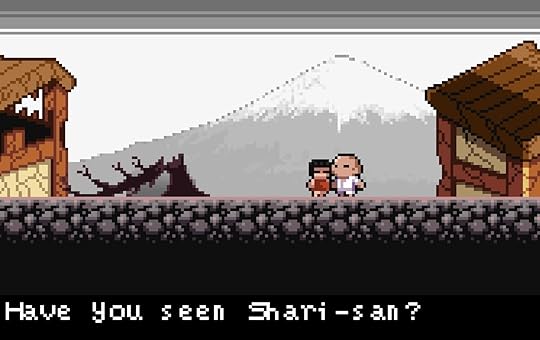
You move among the catastrophe mostly finding houses crumpled on their sides, and wooden memorials to the deceased. These are obvious signposts for the event and the ones that Kurosawa grossly details in his autobiography. It's easy to get lost, too, as certain landmarks you might use as reference for easier navigation re-appear identically in other places. It's in this that you inevitably discover the overwhelming noise of all the devastation.
But more striking to me was how the abstract layout denotes the chaotic architecture of a city torn apart into ruins. This isn't entirely due to it being depicted in the obvious imagery of a destroyed city as described above, but in the confusing, unrealistic multi-layered layout of the area. It has more in common with the levels of floating platforms of Super Mario Bros. than it does a real location that was flattened by a seismic rupture, and where over 140,000 people died.
This illogical construction finds a kind of poetry in the decay and destruction
Staircases are mountainous in their incline, leading to floating rocky platforms and outcrops smothered in domestic ruin. There's no attention given to how these structures might be supported against the pull of gravity, they just are. Structurally, these ruins are so abnormally tall in their verticality that they appear to run parallel with Mount Fuji, which appears in the background and scrolls down with each step you take upwards. This illogical construction finds a kind of poetry in the decay and destruction rather than settling with a more faithful recreation of the historic scene.
Whether intentional or not, Tokyo 1923's penchant for making you feel lost in its composition of rubble and death goes some way to communicating just how much destruction was suffered during the Great Kantō earthquake. Rather than being laid out on a single 2D plane, it's vertically layered so as to give a deeper impression of how widespread it was, and navigating it all is a task. After all, the subject at hand is the greatest damage that Japan had seen before the outburst of the Second World War.
You can download Tokyo 1923 for free here. You can also play it in your browser here.
A new video of Starboretum looks at trees in an otherwordly light
The children of Proteus keep multiplying.
What We Did asks you to sympathize with the criminal's plight
Pippin Barr's latest game puts you on the wrong side of a Carmen Sandiego chase.
Videogames are creating lighting that moves through the world
Volumetric lighting will only increase in importance.
Kill Screen Magazine's Blog
- Kill Screen Magazine's profile
- 4 followers



